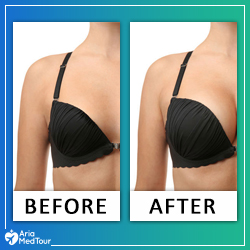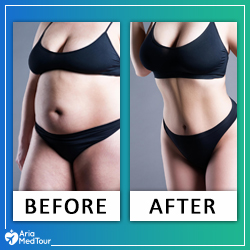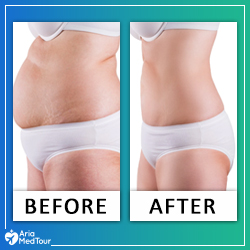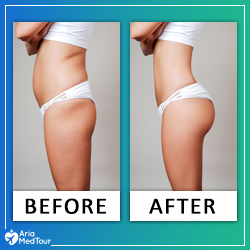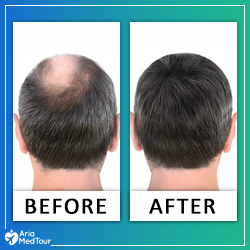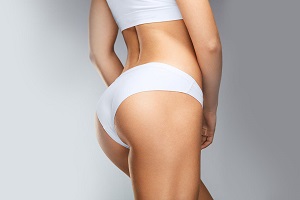Tummy tuck or abdominoplasty is a common procedure aimed at removing the sagging skin and excess fat from your abdomen. It’s mostly selected by women who’ve been pregnant or lost a huge amount of weight but haven’t succeeded in getting rid of their protruded stomachs.

SWELLING AFTER TUMMY TUCK SURGERY
Almost all patients undergoing this surgery experience lower abdomen swelling. The majority of swelling subsides within 2 weeks. However, slight swelling may remain for a few months up to 6 months.
As every patient has its own unique recovery process, you may have a different swelling experience compared to others. Some people see swelling around the incisions. Some face overall swelling below their belly button.
Patients who have had extended abdominoplasty or combined their tummy tuck with liposuction should expect more swelling, which lasts a bit longer than those with a minimal tummy tuck. Furthermore, you would have a more prolonged swelling after abdominoplasty if you’ve got thicker skin.
WHY DOES SWELLING OCCUR AFTER ABDOMINO-PLASTY?
When you undergo a tummy tuck, both the blood supply of the surgical site and lymphatic system are affected. As the surgery needs an incision along the pubic area, the skin above it as well as its blood vessels are manipulated. So, the blood cannot easily reach this area. Then, the skin starts to swell as a reaction.
Further to this, as the lymphatic system, which is responsible for the drainage of the fluid, is cut and altered, fluid accumulation may happen. The fluid may accumulate in the abdominal area or somewhere close to your thighs and legs. That’s why some patients report leg swelling during their recovery. To avoid this, patients should have drains for a few days after the surgery.
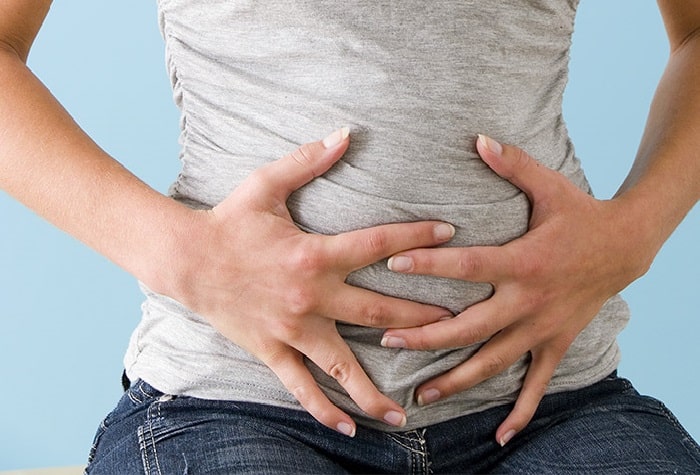
You may experience swelling for a few months after abdominoplasty.
HOW TO MANAGE POST-OPERATIVE SWELLING?
There are several actions you can take to reduce swelling of the tissues after a tummy tuck.
-
Choose the right surgeon
Post-op complications depend greatly on the surgical procedure itself. To have a shorter and easier recovery, you need to find a highly experienced surgeon who can predict and handle your treatment course at its best.
For reducing swelling in abdominoplasty, the less the doctor manipulates or ruptures the tissues the better. So, we recommend you to choose your surgeon and tummy tuck destination wisely.
-
Follow the doctor’s instructions
What’s more important than the surgery? We say “the post-operative phase”. So, listen to your doctor and follow their bits of advice.
-
Use drain tubes
Drain tubes prevent fluids from accumulation, which can, in turn, cause swelling. If instructed by your surgeon, use drain tubes for a few days after your operation.
-
Wear a compression garment
A compression garment can help you control swelling by applying pressure and limiting the amount of fluid in the surgical area. You’ll be recommended to wear this garment for around 2 weeks.
-
Do not wear tight belts
Too much pressure exerted by tight belts can hinder the flow of fluids in the abdominal area.
-
Move your body
As you may know, you’ll be asked to rest and avoid strenuous activities during your recovery period. But you need to keep up a certain amount of movement to help control the swelling better. A short walk, for example, can do a great job in this respect.
-
Take anti-inflammatory medications
Upon your doctor’s prescription, you can take certain medications to reduce inflammation and swelling.
-
Stick to a healthy diet
Healthy food can speed up your recovery for sure. You can manage the swelling by adding fresh fruits, high-fiber foods, and grains to your daily diet. Also, drink water and fruit juices as much as possible as they can stop the fluid accumulation.
DOES SWELLING CAUSE WEIGHT GAIN?
A tummy tuck is not a weight-loss procedure, nor does it cause gaining weight. Some people may lose a few pounds in case they’ve got extensive surgery. Significant swelling may also make them assume that their weight is increased. But it’s not true at all. Abdominoplasty is not to change your weight, but to give you a flat and firm belly.
If you’re one of those who are cautious about every step they are taking, you most probably want to fully understand the nitty-gritty details about tummy tuck when you’ve finally decided to go for it.
For cosmetic surgeries of any sort, side effects like pain, discomfort, swelling, and bruising are expected. A tummy tuck is no exception. You should expect these symptoms after the surgery and you should know that some of them do not go away quickly. Swelling is one example.


